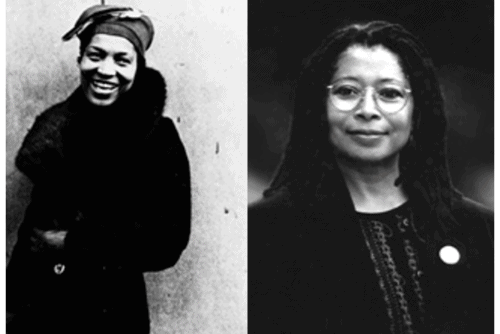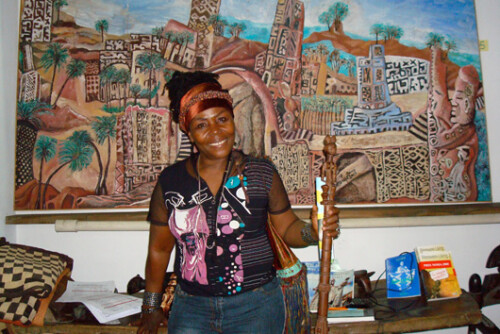Online
Allen, M. (1988). The Development of Communication Networks Among Women 1963-1983: A History of Women’s Media. Women’s Institute for Freedom of the Press. Retrieved 24 April, 2007 from: http://www.wifp.org/tableofcontents.html.
Chaudhry, L. (2006, February). Can Blogs Revolutionize Progressive Politics? In These Times. Retrieved June 5, 2006, from: http://www.inthesetimes.com/
site/main/article/2485/.
Cochrane, K. (2006, March 31). The Third Wave—At a computer near you. The Guardian Unlimited. Retrieved June 5, 2006, from: http://technology.guardian.co.uk/
news/story/0,,1743734,00.html.
Herring, S. C. et al. (2004). Women and Children Last: The Discursive Construction of Weblogs. Into the Blogoshpere. University of Minnesota. Retrieved June 5, 2006, from: http://blog.lib.umn.edu/blogosphere/
women_and_children_pf.html.
Newitz, A. (2006, December). Wikipedia vs. Women. AlterNet. Retrieved 24 April, 2007 from: http://www.alternet.org/story/45730.
Schriefer, A. (2002). We’ve Only Just Begun: Translating Third Wave Theory into Third Wave Activism. The Laughing Medusa. George Washington University. Retrieved June 5, 2006, from: http://www.gwu.edu/
%7Emedusa/thirdwave.html.
Tobias, V. (2005). Blog This! An Introduction to Blogs, Blogging, and the Feminist Blogosphere. Feminist Collections 26 (2-3), Winter-Spring 2005. Retrieved June 5, 2006, from: http://www.library.wisc.edu/
libraries/WomensStudies/fc/fcblogs1.htm.
In Print
Armstrong, J. (2004). Web Grrrls, Guerrilla Tactics: Young Feminisms on the Web. In Gauntlett, D. Horsley, R. (Eds.) Web Studies. 2nd Edition. London: Arnold.
Bell, B. L. (2002). Riding the third wave: women-produced zines and feminisms. Resources for Feminist Research, 29 (3-4), 187-198.
Breitbart, J. and Nogueira, A. (2004). An Independent Media Center of One’s Own: A Feminist Alternative to Corporate Media. In Labaton, Vivien and Dawn Lundy Martin (Eds.) The Fire this Time: Young activists and the New Feminism (pp 19-41). New York: Anchor Books.
Cherny, L. and Weise, E.R. (Eds.). (1995). Wired Women: Gender and New Realities in Cyberspace. Emeryville, CA: Seal Press.
Dicker, R. and Piepmeier, A. (Eds.). (2003). Catching a Wave: Reclaiming Feminism for the 21st Century. Boston: Northeastern University Press.
Dines, G. and J.M. Humez. (Ed.) (2002). Gender, Race, and Class in Media. Sage Publications.
Garrison, E. K. (2000). U.S. Feminism-Grrrl Style! Youth (Sub)Cultures and the Technologics of the Third Wave. Feminist Studies. 26 (1), 141-70.
Hafkin, Nancy J. and Sophia Huyer (Eds.). (2006) Cinderella or Cyberella?: Empowering Women in the Knowledge Society. Bloomfield, CT: Kumarian Press.
Harcourt, W. (Ed.). (1999). Women@Internet: Creating New Cultures in Cyberspace. London: Zed Books.
Harp, D. and M. Tremayne. (2006). The Gendered Blogosphere: Examining Inequality Using Network and Feminist Theory. Journalism & Mass Communication Quarterly, Summer 2006.
Hawthorne, Susan and Renate Klein (Eds.). (1999) CyberFeminism: Connectivity, Critique and Creativity. North Melbourne: Spinifex.
Heywood, L. and Drake, J. (Eds.). (1997). Third Wave Agenda: Being Feminist, Doing Feminism. Minneapolis: University of Minnesota Press.
Heywood, L. (Ed.). (2005). The Women’s Movement Today: An Encyclopedia of Third Wave Feminism. Greenwood Press.
hooks, bell. (1990). Yearning: Race, Gender, and Cultural Politics. Boston: South End Press.
Kennedy, T. (2000). An Exploratory Study of Feminist Experiences in Cyberspace. Cyber Psychology and Behaviour, 3 (5).
Kensinger, L. (2003, November). Plugged in praxis: critical reflections on U.S. feminism, internet activism, and solidarity with women in Afghanistan. Journal of International Women’s Studies, 5 (1).
Leund, L. (2005). Virtual Ethnicity: Race, Resistance And The World Wide Web. Ashgate Publishing.
Luckman, S. (1999). (En)Gendering the Digital Body: Feminism and the Internet. Hectate, 25, 36-46.
McGrath Cohoon, J. and Aspray, W. (2006). Women and Information Technology: Research on Underrepresentation. The MIT Press.
O’Riordan, K. and Phillips D. (2007). Queer Online: Media Technology and Sexuality. Peter Lang Pub Inc.
Richards, A. and Schnall, M. (2003). Cyberfeminism: Networking the Net. In Robin Morgan, (Ed). Sisterhood is Forever (pp. 517-525). New York: Washington Square Press.
Ross, K. and Byerly, C.(Eds.). (2004). Women and Media: International Perspectives. Oxford: Blackwell Publishing.
Senft, Terri. CAMGIRLS: Webcams, LiveJournals and the Personal as Political in the Age of the Global Brand. New York: Peter Lang. Forthcoming.
Shade, L. R. (2002). Gender & Community in the Social Construction of the Internet. New York: Peter Lang.
Sherman, A. (1998). Cybergrrl! A Woman’s Guide to the World Wide Web. New York: Ballantine Books.
Siegel, D. (2007). Sisterhood, Interrupted: From Radical Women to Grrls Gone Wild. New York: Palgrave MacMillan.
Thomas, Sue. (2004) Hello World: Travels in Virtuality York: Raw Nerve Books.
Valenti, J. (2007). Full Frontal Feminism: A Young Woman’s Guide to Why Feminism Matters. Seal Press.
Wilson, T. (2005, May). Women in the Blogosphere. Off our Backs, May/June Issue.
Youngs, Gillian. (2007) Global Political Economy in the Information Age: Power and Inequality. London: Routledge.




